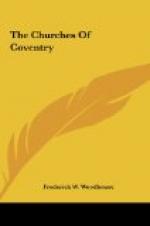Many interesting entries of expenditure are to be found in the gild accounts showing how the Eve of St. John (Midsummer Eve) and other festivals were celebrated before the suppression of the gilds by Edward VI. In 1541 we have the following (the spelling is somewhat modernized):
Expenses on Midsummer Even and on the day,—Item, 2 doz. & a half cakes, 2_s_. 6_d_.; spice cakes, 12_d_.; a cest’ ale and 4 gals. 4_s_.; 2 gals, claret wine 16_d_.; 2 gals, malmsey, 2_s_. 8_d_.; 2 gals, muskedell 2_s_. 8_d_.; to Mr. Mayor 3_s_. 4_d_.; the Mayor to offer, 8_d_.; to priests, clerks and children, 2_s_. 4_d_.; the waits, 6_s_. 8_d_.; to poor people 6_s_. 8_d_.; to the cross-bearers and torch-bearers, 8_d_.; the bellman, 4_d_.; the hire of pots, 4_d_.; boughs, rushes and sweeping, 8_d_.; a woman 2 days to cleanse the house, 4_d_.; half a hundred 3_d_, nails, 1-1/2_d_.; half a pound of sugar, 4-1/2_d_.; to the crossbearer and torchbearer for St. George Day, Holy Rood Day, Shire Thursday and Whit Sunday, 12_d_.; to 2 children for the same days, 6_d_. Summa (total) 38_s_. 2_d_.
That these anniversaries and wakes led to much unseemly revelling we have evidence that cannot be gainsaid. The Trinity Gild decided in 1542 “that no obite, drynkyng or com’en assemblie, from henceforth shall be had or used at Babalake, except onelie on Trinitie even and on the day, which shall be used as it hath been in tymes past. And that also the P’sts of Babelack shall say dirige on midsum’ even and likewise masse of requiem on the morrowe, as they have used to doo. And that the Meire shall not come down thether to dirige ov(er) night for dyv’s considerac’ons and other great busynes they used. And on the morowe thei to go thether to masse and brekefast, as thei have used to doo.”
Dugdale quotes from an old MS. an interesting passage bearing on this question:
“And ye shall understond and know how the Evyns were furst found in old tyme. In the beginning of holi Chirche, it was so that the pepull cam to the Chirche with candellys brennyng and wold Wake and come with light toward nyght to the Chirch to their devocions; and afterwards they fell to lecherie and songs, daunces, harping, piping and also to glotony and sinne and so turned the holinesse to cursaydnesse; wherefore holi faders ordeined the pepull to leve that waking and to fast the Evyn. But it is called Vigilia, that is Waking in English and it is called the Evyn, for at Evyn they were wont to come to Chirche.”
In 1362 Queen Isabella helped to procure from the bishop a licence for one Robert de Worthin, priest, to become an anchorite and to inhabit a hermitage attached to the north aisle of the chancel. Traces of the foundations of this have been found on the site of the modern vestry.
When the college was suppressed in 1548 the King granted to the mayor, bailiffs and corporation, on their petition, the church and its appurtenances in Free Burgage for ever on payment of 1_d_., per annum and gave them “all the rents, revenues and profits of the said church.”




